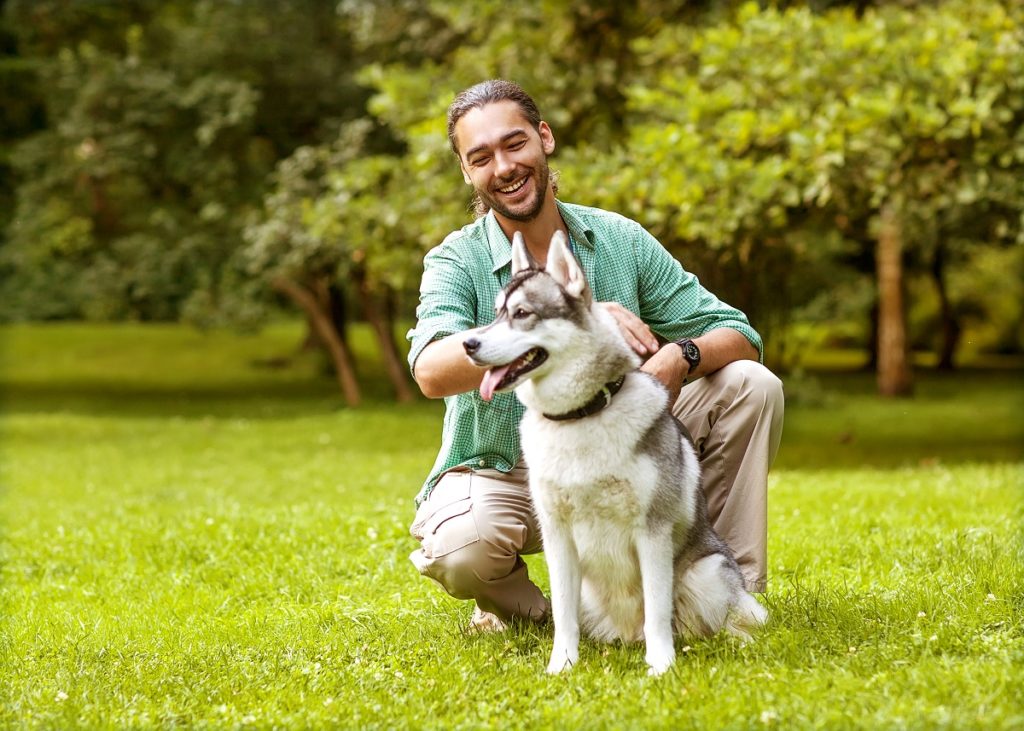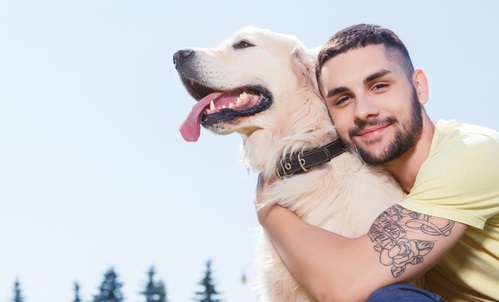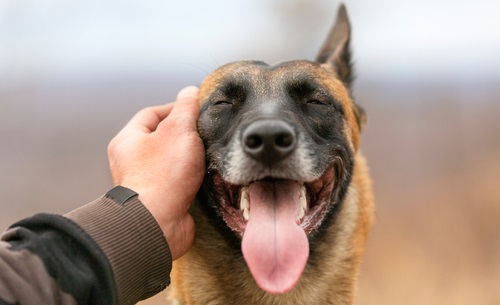Smart, sweet, and loyal—there’s a reason dogs make such amazing emotional support animals. For those of us looking for little extra help from our furry friends, an emotional support dog (ESD) can be a tailing-waggingly good way to feel secure in stressful situations.
That said, you may not know how to train an emotional support dog.
From common commands to specialized techniques, we’ve developed the ultimate how-to guide for emotional support dog training. If you’re ready to turn your pup into a pillar of emotional assistance, read on.
Step 1: Teach The Basic Commands
Before jumping into the more complex aspects of emotional support training, it’s important to acquire the fundamentals.
It can be hard to teach an old dog new tricks, so we encourage owners to start training the emotional support dog when they’re a puppy. That said, it’s still possible to train an adult dog as long as you’re willing to put in the time and effort.
Consider teaching the following commands to your dog through these tried and true methods to create a solid foundation for future training.
Bathroom Training
Dogs are full of surprises, some of them not all that pleasant. For new pups, potty training is the first step. Housebreaking your dog is essential if you hope to travel frequently with them.
For quick and effecting house training, follow these guidelines:
- Consistency – Keep your pup on a regular schedule and they’ll have a headstart on proper potty training. If they can anticipate their next opportunity to go outside, you have a better chance of avoiding accidents.
- No water at night – Young pups can have trouble making it through the night without a bathroom break. Consider taking away their water dish a few hours before bedtime to assure they’ll sleep soundly.
- Crate-training and confinement – As much as you wish you could always be with your pup, you may have to leave them alone for short periods of time. It’s recommended that you crate train or confine your pet to a small room when you’re not home to avoid potential accidents. It can also help for future travel plans if your dog is comfortable in their crate.
Sit
This command should come naturally to most dogs. For generations, dogs have been trained to sit, so you should have your pup popping a squat in no time.
To train your dog to sit, try the following tips and tricks:
- Use a treat – Pick out a favorite dog treat and hold it directly in front of your pup while repeating the word “sit.” While their eyes are focused on the treat, you can move it up and backward to encourage them to move into a sitting position.
- Positive reinforcement dog training – Let your dog know you’re proud of them. Vocalize your happiness when they sit correctly and let them know they’re a good dog.
- Practice makes perfect – With all commands, they require time and diligence for your dog to fully master. Consistency is key, so keep up your training on a daily basis and try to create routines and schedules to further reinforce the training. This goes for sitting and just about everything else.
Stay
After “sit” comes “stay.” Sometimes you can teach both of these commands at the same time, but it’s helpful to make sure your dog understands “sit” before adding the “stay” command.
When teaching “stay,” try the following steps:
- Place your hand, palm out, toward your dog
- Repeat the command
- Move backward slowly
- Offer a treat and positive reinforcement for a job well done
Come
A well-trained dog needs to heed your call. Teaching the “come” command can be pretty simple. Still, like all commands, it’s mastered through concise instructions and repetition.
Try the following method for teaching the “come” command:
- Leash your dog and use it to guide them toward you
- Repeat the command
- Vocalize your enthusiasm
- Provide treats and positive reinforcement
Down
Puppies are prone to jumping and pawing when they’re excited, but if this behavior isn’t corrected while they’re young, it can lead to bad habits when they reach maturity.
A down position can be essential for allowing your dog to join you at a restaurant, on an airplane, or in an office building.
To teach your dog the “down” command follow these steps:
- Place a treat in front of your dog’s face
- Move the treat toward the floor
- Wait until your dog is fully lowered to give them the treat
- Introduce a hand signal—arm out, palm pushing downward
Leave It
A proper emotional support dog will have a strong will. That means being able to ignore stimuli and listen to your commands above all else. The “leave it” command can be useful for redirecting your dog’s attention, allowing you to keep them from chasing animals, going after food, or otherwise misbehaving in public.
Teaching the “leave it” command is made easier with a leash and plenty of treats. Try the following steps to acclimate your dog to this command:
- Place food and treats on the floor
- As your dog begins moving toward the food repeat the “leave it” command
- Use treats in your hand to lure them from the food on the floor
- Use your leash to guide
- Repeat until they are able to completely ignore the food on the floor
Step 2: Explore Specialized Techniques
After basic training, you can progress to more specialized training to prepare your dog for their responsibilities as an emotional support animal.
The most popular of these techniques is deep pressure therapy (DPT).
Through deep pressure therapy, an emotional support dog will apply pressure to specific areas of your body. By pushing on these pressure points, your dog may be able to help relieve discomfort. In fact, studies have shown that DPT can have powerful calming effects for those suffering from a variety of stress-related issues.1
To train your dog in deep pressure therapy, try the following steps:
- Get them in position – To properly apply deep pressure therapy, you’ll need to be laying down, most likely on a couch or a bed. The first part of training for this activity will require you to encourage your dog to climb up to where you’re laying. Use the “up” command and positive reinforcement so that they understand it’s okay to get on the furniture—at least in this situation.
- Place their paws – Your dog won’t innately know where to put their paws, show them by carefully and calmly placing them on your pressure points. Use vocal reinforcement and treats to show them when they’re in the correct position and readjust them when they get off target.
- Create verbal commands – “Off” or “paws” can be helpful commands for starting and stopping deep pressure therapy. Find the command that works best for you and your pup and you may be able to initiate this technique with one simple word.
For small dogs, DPT will take their entire body weight, while larger dogs may only need to use their paws. As well, the preference of applied pressure will vary from person to person, so work with your dog to discover what’s best for you. Think of it as a team effort.
Step 3: Making Sure Your Dog Is Cool, Calm, and Prepared
With training mastered and powerful techniques learned, it may be time for you and your dog to apply for an emotional support animal letter. This is an official document signed by a mental health professional that confirms that your dog is necessary for assisting in emotional support. After acquiring this letter, you and your pet will be granted specific legal protections, making it easier to travel and find housing with your pet.
Getting an emotional support animal letter is a fairly straightforward consultation process, and with a full regiment of training your dog should be well prepared to take on the responsibility. In addition, before your consultation, it can be helpful to find a few ways to help your dog remain calm in stressful situations.
Often, dogs look to their owners to provide stability, but if you’re in the middle of an anxiety attack or feeling stressed yourself, you may want to examine additional ways to build resilience and emotional strength for your pet.
Consider the following ways to help your dog remain cool in heated situations:
- CBD supplements – With the advent of puppy-friendly supplements, you may be curious to see the benefits of CBD on your pup. Hemp-based supplements can encourage calm behavior and offer a range of health advantages as well.
- Exercise – One of the best ways to keep your dog’s mental and physical health in tip-top shape is through consistent exercise. A run through the park, a game of fetch, or an extended walk can be just the thing for keeping your dog stress-free.
- Special commands – If your emotional support dog has taken to their training, you may be able to create more detailed or specialized commands when confronting stressful situations. The right word or phrase could signal to your dog that needs to stay close, keep calm, and offer you direct support.
Keep Your ESA Happy With Canna-Pet
Training an emotional support animal can require some serious work, but at the end of the day, it’s all worth it to have a furry friend ready to comfort you during tough moments. If you’re looking for a way to thank your dog for their service or a great option to help with the training process, look no further than Canna-Pet.
At Canna-Pet, we’ve put in the time to craft quality treats that can enrich your dog’s life. That means delicious flavors with all the organic benefits of hemp-CBD, designed with your pup in mind. Visit Canna-Pet today to pick up the perfect treat for your ESA—let them know just how appreciative you are.
Sources:
- Better Pet. The fully accessible guide to training an emotional support dog. https://betterpet.com/emotional-support-dog-training/
- Grandin. Calming Effects of Deep Touch Pressure in Patients with Autistic Disorder, College Students, and Animals. http://www.grandin.com/inc/squeeze.html
- Humane Society. How to house train your dog or puppy. https://www.humanesociety.org/resources/how-house-train-your-dog-or-puppy






